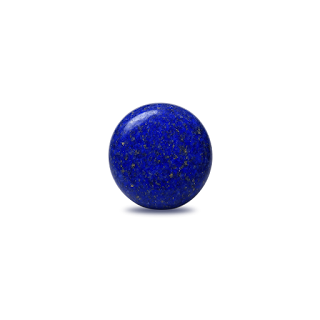For millennia, the deep celestial blue of Lapis Lazuli has captivated civilizations, artists, and spiritual seekers. This enigmatic gemstone, speckled with golden pyrite flecks, is more than a mineral-it’s a bridge between Earth’s geological wonders and humanity’s artistic and metaphysical aspirations. In this comprehensive guide, we’ll explore the rich history, geological origins, healing properties, and modern uses of Lapis Lazuli, offering insights for collectors, jewelry enthusiasts, and curious minds alike.
The Ancient Legacy of Lapis Lazuli
Lapis Lazuli’s story begins over 6,500 years ago in the rugged mountains of Afghanistan, home to the world’s oldest known mines in Sar-e-Sang. Prized by pharaohs, emperors, and scholars, this stone symbolized power, wisdom, and divinity.
1. Egyptian Royalty & the Afterlife: Ancient Egyptians associated Lapis Lazuli with the night sky and the heavens. It adorned Tutankhamun’s burial mask and was carved into scarabs and amulets to guide souls in the afterlife. Ground into powder, it created the iconic ultramarine pigment for eye shadow and temple art.
2. Mesopotamian Mysticism: Sumerians believed the stone carried the essence of their deities, inscribing prayers on Lapis tablets. The Epic of Gilgamesh references it as a symbol of royalty.
3. Renaissance Masterpieces: Medieval artists like Michelangelo used Lapis-derived ultramarine to paint the Virgin Mary’s robes in the Sistine Chapel, a color so costly it rivaled gold.
This historical tapestry cements Lapis Lazuli as a cornerstone of human culture, art, and spirituality.
Geological Formation: How Nature Crafts Lapis Lazuli
Lapis Lazuli isn’t a single mineral but a metamorphic rock formed over millions of years. Its creation requires a unique blend of elements:
1. Mineral Composition: Primarily lazurite (25-40%), which gives its signature blue, alongside calcite (white streaks), pyrite (golden sparkles), and traces of sodalite or augite.
2. Formation Process: Heat and pressure transform limestone and marble deposits, infusing them with sulphur-rich fluids. This metamorphosis occurs in mountainous regions, often near tectonic plate boundaries.
3. Mining Locations: While Afghanistan’s Badakhshan mines remain the gold standard, significant deposits exist in Chile (light blue varieties), Russia (Lake Baikal), and the U.S. (California).
The stone’s Mohs hardness of 5-5.5 makes it softer than quartz, requiring careful handling—a small trade-off for its celestial beauty.
Physical and Metaphysical Properties: Beyond Aesthetics
The Allure of Color and Light: Lapis Lazuli’s value hinges on its rich “cornflower blue” hue, intensified by minimal calcite and even pyrite distribution. Top-grade stones feature uniform color with shimmering gold flecks, while lower grades show white or gray streaks.
Spiritual and Healing Energies: In holistic practices, Lapis Lazuli is a “stone of truth,” revered for its alleged metaphysical properties:
- Third Eye & Throat Chakras: Believed to enhance intuition, clarity, and honest communication.
- Emotional Balance: Said to alleviate stress, foster self-awareness, and combat negative thoughts.
- Physical Wellness: Historically used to soothe migraines, boost immunity, and purify blood.
Note: These claims are rooted in tradition, not scientific evidence, but highlight the stone’s cultural resonance.
Lapis Lazuli in Modern Jewelry and Design
Today, Lapis Lazuli remains a favourite among jewelers and designers for its bold color and affordability compared to sapphires.
- Jewellery Styles: Cut into cabochons, beads, or cameos, it’s featured in statement necklaces, earrings, and rings. Pairing it with silver or gold accentuates its vintage charm.
- Home Décor: Sculptures, inlaid tabletops, and wall art bring its regal energy into living spaces.
- Fashion Trends: Designers like Tiffany & Co. and David Yurman have incorporated Lapis into high-end collections, while bohemian brands use it for earthy, spiritual aesthetics.
Caring for Your Lapis Lazuli: Preservation Tips
Due to its calcite content, Lapis requires gentle care:
- Avoid Harsh Chemicals: Clean with a soft, damp cloth-never steam or ultrasonic cleaners.
- Store Separately: Prevent scratches by keeping it away from harder gems.
- Limit Sun Exposure: Prolonged light may fade its vibrant color
Buying Guide: How to Choose Authentic Lapis Lazuli
With imitations like dyed howlite flooding the market, discerning real Lapis is key:
- Color & Texture: Look for uneven color distribution and natural pyrite flecks (not surface paint).
- Price Point: High-quality Afghan Lapis costs 10-100 per carat; unusually cheap stones may be fake.
- Seller Reputation: Purchase from certified gemologists or reputable dealers with authenticity guarantees.
Conclusion: The Eternal Resonance of Lapis Lazuli
From ancient tombs to modern runways, Lapis Lazuli’s journey through history is a testament to its enduring allure. Whether you’re drawn to its hypnotic beauty, historical mystique, or spiritual promise, this stone offers a tangible connection to humanity’s shared heritage. As you explore the world of gemstones, let Lapis Lazuli remind you that Earth’s treasures are as much about stories as they are about substance.













0 Comments